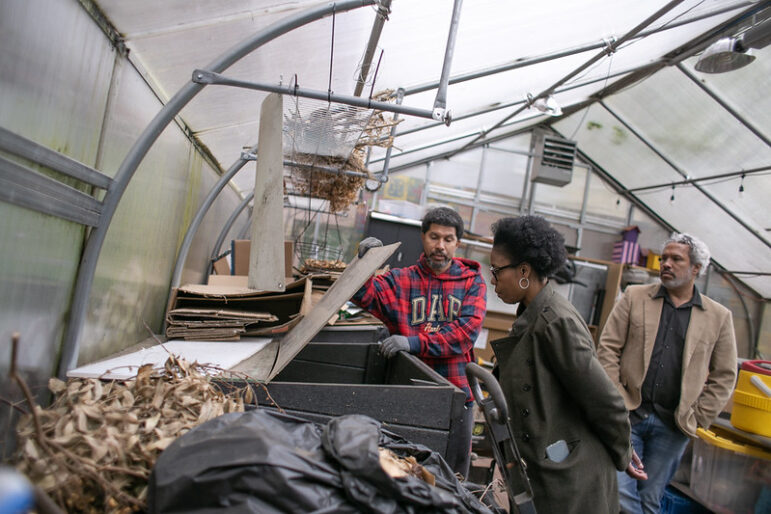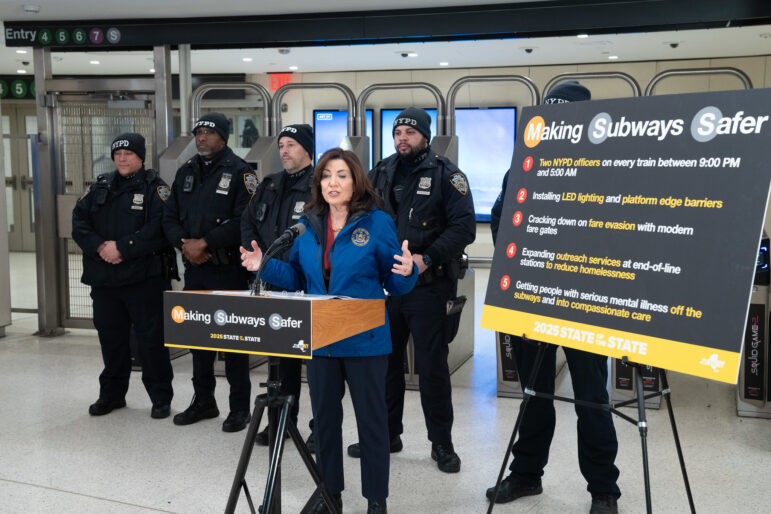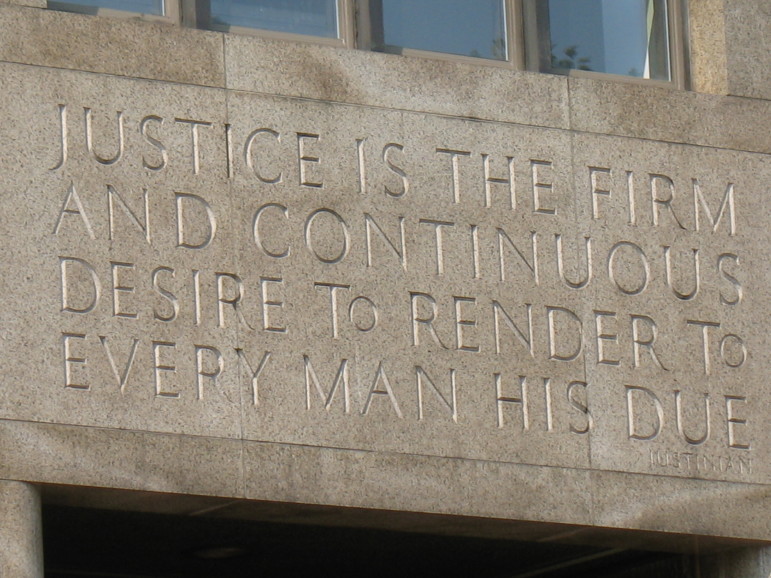
Ed Reed/Mayoral Photography Office.
The mayor picked up on a self-examination that President Obama wanted to occur across the country, but President Trump halted.The de Blasio administration released a draft report Tuesday listing six broad goals for the next five years aimed at addressing the impact of decades of discriminatory housing policies and practices.
The impetus for the “Where We Live” report goes back to the Obama administration, when the federal government wanted to strengthen enforcement guidelines in the milestone Fair Housing Act of 1968.
Under the 2015 Affirmatively Furthering Fair Housing rule (AFFH), the federal Department of Housing and Urban Development moved to require states and cities to study how their housing policies affect segregation. But the Trump administration stalled that effort. New York City in 2018 launched its own segregation study to fill the vacuum left by the feds.
The de Blasio administration said the draft study released this week was informed by conversations with New Yorkers in communities around the city.
The data on race and social conditions
In the fair housing analysis section of the draft Where We Live report, the administration broke the city’s population into the four major racial and ethnic groups defined under federal demographic guidelines. Across the five boroughs, 32 percent of residents are White, 29 percent Hispanic, 22 percent Black, and 14 percent Asian or Pacific Islander, according to the data they collected from the American Community Survey.
The average median income for the city is estimated at $55,023 according to the American Community Survey between 2012-2016. The racial population with the highest median income are White household which have a median income of $79,743 compared with Asian/Pacific Islander households which have a median income of $58,540. Black households have a median income of $43,326 and Hispanic households have a median income of $37,281, according to the ACS data.
The combination of race and income translated into starkly different social conditions, according to the report.
The city found that in 2017, White borrowers accounted for 48 percent of new loans for owner- occupied, one- to four-unit properties in the city, while Black and Hispanic borrowers each accounted for less than 10 percent, far less than their share of the total population among New Yorkers. Asian borrowers accounted for 38 percent of new loans for owner- occupied, one- to four-unit unit properties in the city.
Black and Hispanic household also experienced lower quality housing conditions. For example, Blacks and Hispanics were 20 percent more likely to experience maintenance problems like lack of heat, peeling paint, or the presence of rodents compared with only 6 percent of their Asian and White counterparts.
Examining housing stability by race for public-school students, the city found that students of color are more likely to experience “unstable housing,” such as being doubled-up with family and friends or living in a type of shelter or some other form of temporary housing, than White children. According to the Department of Education’s 2017-2018 numbers, 13 percent of Hispanic and Black students experience unstable housing when compared with 5 percent of the Asian student population and 3 percent of White students.
Exposure to violent crime also varies dramatically across racial lines. “Black residents experience the highest exposure to violent crime in the neighborhoods where they live (6.0 per 1,000 people), a rate twice that of White New Yorkers (2.6 per 1000 people) and Asian/PI New Yorkers (3.0 per 1000 people). The rate for Hispanic New Yorkers, also higher than the city rate, was 5.1 incidents per 1,000 people,” the report reads.
A complex picture of neighborhood change
The draft report also took a look at neighborhood change.
“For many New Yorkers who participated in our Community Conversations and Fair Housing Stakeholder Group, ensuring equitable access to opportunities and amenities in all neighborhoods—regardless of the racial demographics of those neighborhoods—was more important to fulfilling the Fair Housing Act’s spirit than the composition of the people who live in a particular neighborhood. Many New Yorkers also expressed concern that the way in which some neighborhoods are changing—namely through the increased presence of wealthier, White residents in areas with predominant populations of people of color—has created a sense of fear that long-standing residents and businesses will be economically displaced by resulting neighborhood change,” the report reads.
According to the draft report, the most significant changes appear in the patterns of where White New Yorkers live. In 1990, White New Yorkers were the predominant group (75% or more) in 57 out of 188 Neighborhood Tabulation Areas (also known as NTA which uses data from the U.S. Census Bureau) across the five boroughs, and were the majority group (between 50 to 75 percent) in an additional 35 NTAs. Today, White New Yorkers are predominant in only 16 NTAs and are the majority group in 34 NTAs.
The city found that the most dramatic changes occurred between 1990 and 2012-2016 in Queens—including Ozone Park, Woodhaven, and College Point neighborhoods—where the share of White New Yorkers in the neighborhoods decreased between 50 and 63 percentage points. The largest increases of the White population, between 25 and 32 percent, occurred in Brooklyn, including parts of Williamsburg (which was rezoned under the Bloomberg administration in 2005), Bedford, Clinton Hill, and Prospect Heights. The maps also indicated that White New Yorkers did not populate areas such as the South Bronx, parts of northern Manhattan, and large areas of central Brooklyn and southeast Queens, and remain the majority in large parts of Lower and Midtown Manhattan, southern Brooklyn, and Staten Island.
The report showed the Hispanic New Yorkers population increased between 1990 and 2016 in Hunts Point, Longwood and Kingsbridge in the Bronx; North Corona in Queens, Bushwick North in Brooklyn and Washington Heights South in Manhattan. The Hispanic population decreased between 15 to 35 percent in parts of Williamsburg, Downtown Brooklyn, and Sunset Park.
The report found that Black residents in 1990 were predominant in Central Harlem and multiple parts of central Brooklyn and southeastern Queens. But by 2016, the Black population fell to less than 75 percent in Central Harlem, Bedford-Stuyvesant, and northern Crown Heights. However, Black New Yorkers remain a majority in neighborhoods such as East New York, Eastchester-Edenwald-Baychester in the Bronx, and Hollis, Queens.
Despite being only 14 percent of the city’s overall population, Asians hold a majority in several Queens neighborhoods including Flushing and parts of southern Brooklyn and the city found their population decreased by the fewest number when compared to Whites, Blacks, and Hispanics.
The report says, “Overall, the share of New Yorkers living in the least diverse neighborhoods decreased slightly over the last three decades.”
Policy moves: Some new, some not
Over the past two years, the report says, the city “engaged with hundreds of residents, over 150
community-based and advocacy organizations, and dozens of governmental agencies” to discuss the city’s history, current conditions and potential policy responses.
The city has narrowed its focus to six goals using existing city programs and creating new initiatives as well.
The administration says it will strengthen fair housing enforcement by expanding testing investigations for illegal discrimination and increasing agency resources for addressing complaints with a focus on “source-of-income discrimination, reasonable accommodation requests, and failures to construct or renovate housing according to accessibility requirements” including examining regulations to address co-op association discrimination.
It will also consider drafting legislation to address housing discrimination against New Yorkers who have a history with the criminal justice system and amending the city’s Human Rights Law to include prohibiting discrimination based on a person’s source of income.
Additionally, the city says it will build on the Department of Housing Preservation and Development (HPD)’s new guidelines that remove barriers that “impede residents’ housing choices and may be used as proxies for discrimination (including credit history and broker fees) without causing unintended consequences, such as increased rents or more stringent guarantor requirements.”
Another goal is to “facilitate equitable housing development” in the city and the region. That includes examining opportunities to accelerate land-use review and remove obstacles in the approval process for approval of affordable housing projects, especially in areas with more amenities, and to support state legislation for changes to the state cap on residential floor area ratio. The current law does not allow the floor area ratio to exceed 12.0 in the city. The plan is for the city to also explore new housing options in the city’s historic districts and train community boards, groups and elected officials on the city’s responsibility to affirmatively further fair housing.
The city also says it will strengthen coordination of housing and land-use policies across the city by developing new assessment tools, and making more data available. This strategy would also include establishing a working group with local governments in the tri-area to develop a housing and transit agenda.
Another goal is to increase housing opportunities, especially for low-income New Yorkers, in more affluent neighborhoods by creating a task force to make recommendations on zoning, land use and regulatory actions. The city says it will also examine the possibility of building on underutilized public land (including NYCHA properties) for extremely- and very low-income households, homeless, and other special needs populations. It plans to revise the HPD evaluation process for developments that use vouchers to support additional affordable and supportive housing projects and also “restrict the use of middle-income options under the 421-a tax incentive program in neighborhoods where market conditions allow for new housing development without them.”
The city would also like to expand publicly-supported housing to more New Yorkers by improving Housing Connect 2.0, the website where New Yorkers can apply for lottery housing; broaden the Housing Ambassadors program (where local nonprofits help potential Housing Connect applicants with the application process) particularly for applicants using rental assistance and take steps to make housing as inclusive as possible for non-citizens, the disabled and people who have been incarcerated.
Some of the goals align with the mayor’s long-held policy priorities, like converting NYCHA units to Section 8 and developing mixed-income housing on NYCHA land to generate revenue to support public housing. The city’s HomeFix program, which provides access to affordable low- or no-interest and potentially forgivable loans for home repairs to eligible owners of one- to four-family homes, and a long list of recently enacted tenant protections are also on this list. So is exploring innovative housing strategies such as community land trusts or mutual housing associations.
Other policies on the to-do list include implementing the Uniform Partition of Heirs Property Act, exploring broader use of cease and desist zones, ensuring access to rental assistance, ensuring housing access for people with disabilities and investing city capital dollars in a more equitable fashion.
Beyond the report
It’s not clear how many of the newer strategies outlined in the report will be taken up by Mayor de Blasio during the two years left in his term, as opposed to being left to his successor to consider adopting. What is certain is that the Where We Live strategy is hardly the only place where questions about race, housing and development are being argued.
In December, community organizations and Public Advocate Jumaane Williams launched a legislative campaign to include a racial impact study within the city’s environmental review process in order to address inequity and displacement in communities that face major land use actions.
Also last month, a state judge annulled the 2018 Inwood rezoning, citing the city’s failure to consider several potential impacts—some of which implicated race—in its environmental review before the rezoning.
On Tuesday, just after New York’s report came out, the Trump administration proposed to roll back parts of the AFFH rule and said its proposal would redefine fair housing standards by placing an emphasis on housing choice rather than discrimination. The HUD proposal also plans on reducing some of the regulations in place under the 2015 AFFH rule, the Associated Press reported.
The final Where We Live report is due later this year; the city is now taking feedback on all aspects of the report. The public comment period will extend from January 7, 2020 to March 7, 2020. The comments received from the public will be summarized and published in the final version of the Where We Live NYC Plan. The city also plans on holding a testimony hearing scheduled for February 6, 2020 at 5:30 in the City Planning Commission Hearing Room, Lower Concourse, 120 Broadway in Manhattan.
You can read the report here.









2 thoughts on “City Hall Maps Steps to Deal With Impact of Decades of Racist Housing Policies”
If deBlasio was smart (LOL!) he’d leave NYC’s good neighborhoods alone. The only result of this social engineering will be the deterioration of NYC’s stable middle-class neighborhoods. The poor will bring all their crime and disruption with them as they always have.
To Native new Yorker: you forgot to mention how some “New Yorkers” have blatantly discriminated against the poor for hundreds of years. Your racist diatribe is why we need legislation to prevent discrimination.